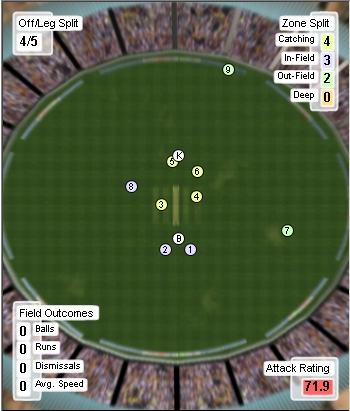|
This is part of a series on How to exploit batsman's weaknesses. To see the other weaknesses click here.
The low backlift is seen at every level from school matches to Tests. Yet, at lower levels it's a batting weakness that can be used to your advantage.
Not every batsman with a low backlift will be as good as Paul Collingwood because a low backlift is very limiting to technique. Here is what you can do when you see a player with this problem.
How to spot the weakness
There are two types of low backlift, but they both are obvious, especially from the side.
The cocked wrists version looks like this:
Here the batsman has picked the bat up with his hands and wrists only, keeping his front arm straight, stopping the classic diamond shape from being formed.
The second form of low backlift is similar, looking like this:
Again there is no diamond shape because the batter has not bent his elbows and raised the hands above his hips. The result is a backlift that barely gets over the stumps.
Why is it weakness?
From a low position, the batsman is limiting his scoring options and becomes especially vulnerable to good spin bowling.
When the hands are left low it's difficult to use gravity to generate enough force to have a good swing. As a result the batsman with the low backlift tends to compensate by jabbing at the ball and using the bottom hand to create power.
This has two effects:
1. When hitting straight bat shots the ball tends to go more leg side as the batsman hits across it with a strong bottom hand
2. When driving on the front foot the ball is more likely to go in the air.
A low backlift can also be a sign of low confidence. It's natural to compensate, say, for getting bowled by lowering the backlift, so the batter will be harder to get out if he is bent on defence, but not so clever when he is attacking.
How to bowl to a low backlift
Err on the side of a fuller length as the low backlift player drives in the air. If you bowl short because of the strong bottom hand the batter can cut and pull easily.
Your line is best on the off side as the batsman is strong on the leg side.
Put the batter under pressure with short midwicket and extra cover when he or she is first in to show you know his or her weakness.
Another tactic is to exploit any extra bounce in the wicket. With such low hands there is a good chance of gloving the ball against both spin and seam.
If your bowling is getting extra bounce get in a short leg, leg gulley or both.
Combine this with a field to cut off his favoured shots. For example, here is a sample field:

In this field a seamer is bowling on a bouncy wicket and wickets are the priority. The captain has hedged his bets a bit. He has a slip, short extra and short midwicket for the drives and a leg gulley for the short ball. Deep midwicket is set back to stop the batsman shovelling the ball over the top (his best shot).
The final tip to getting a low backlift batsman out is to keep him or her in the game. A low backlift on a blocker stops becoming a flaw and starts becoming an advantage.
In limited over matches this isn't a problem, but if the draw is possible you need a captain who can dangle the carrot to prevent the batsman blocking out.
Want to improve your skills so you can bowl to these tactics or iron out your batting weaknesses? PitchVision Academy has an online coaching course to help you from the world's finest coaches.
Discuss this article with other subscribers
|

.jpg)




.jpg)


